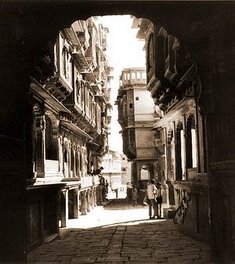The last few weeks were spent in Varanasi. Our site coordinator was a religion professor at Banaras Hindu University, thus every day was packed with learning more about Hinduism, Islam, and Buddhism, primarily. Excursions were made to places such as the shrine of Kabir, Sarnath (site of the Buddha's first sermon), temples of Lord Shiv, Durga, Vishnu, Kali, and most of the ghats of Banaras. We followed some of the primary pilgrimage routes, witnessed exorcisms, and met with Tantric masters that use skulls to commune with restless spirits. Despite the recent bombings and diversity of religions, I still found Varanasi to be a notably welcoming city, if not peaceful.
To conclude the semester where we began, we arrived in Delhi yesterday via train. This coming week focuses primarily on wrapping up interviews and giving presentations on our fieldwork before the program officially ends on Dec. 9th.
Just before leaving the States in August, I had the powerful urge to stay home out of the insecurities that anticipation inevitably brings. The anticipation of India also flooded my senses with an overwhelming feeling of excitement as I prepared to embark to a country that I knew so little about.
I can say that similar feelings of both excitement and trepidation are now rising as my classmates and I prepare to leave. India is a very special place and looking back on the last four months has caused all of us here to feel nostalgic for it. In many ways, we've grown so accustomed to the culture here that the thought of being back in the States seems more alien than being in India does.
This country is a land of endless paradoxes that frustrate some people and fascinate others. Much of what determines what you find depends on personal experiences and the specific time and place. To say that this country is diverse is an incredible understatement. Some people have come and told me they would never return while others could not get enough of it. I can say with absolute certainty that I am personally among the latter and have grown quite attached. This will be my last post, if things go accordingly, for at least a year and a half.
02 December, 2007
10 November, 2007
From Jaipur to Varanasi
It's been a while since my last post, following is a brief overview.
A few days after Amritsar we went to Agra to see the Taj Mahal, Fatehpur Sikri, and Shah Jahan's Agra fort. We then took a train Southwest to the state of Gujarat and stayed in a small village near the coast of the Arabian sea. For seven days we were in a Gandhian school called Babapur Ashram, adjusting to village life.
We made excursions to a number of religious sites including the Hindu pilgrimage site called Somnath and the Jain pilgrimage site of Palitana. The temple at Palitana was absolutely breathtaking.
After Babapur, a few days were spent in the Gujarat capital of Ahmedabad and we stayed in another Gandhian Ashram, this being the first one that Gandhi established and it was used for his headquarters until approximately 1930, called Vidyapeeth.
Another train ride was due, the next one being to the desert state of Rajasthan where I stayed in Jodhpur, the blue city, with a few friends for a four day break.
Afterwards we went to Jaipur, capital of Rajasthan, a city that is pulsing with life (one of the densest cities in India).
I've been living with my host family in Jaipur for a month now, continuing Hindi lessons, fieldwork, and lectures at the University of Rajasthan in earnest. This leg of the trip has been the most profound as living with my host family has drawn me into Indian culture more deeply than before. My family is a joint family: mother and father, two sisters, grand parents, uncle and aunt, and a German shephard.
Last night we celebrated Diwali, the festival of lights, with fireworks and pooja. This is the biggest Hindu holiday, which commemorates the end of Lord Ram's exile in the forest (hence the lights, to the light the way for his return).
In 36 hours, however, we leave Jaipur for Varanasi, the last substantial leg of my trip. Varanasi is arguably the holiest city in India and the oldest continually living city in the world.
Following are photos that roughly encompass the last 1.5 months.
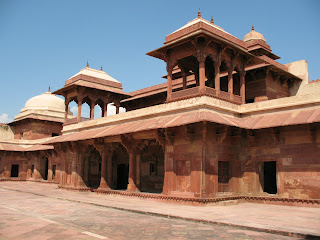
Akbar the Great's Fatehpur Sikri
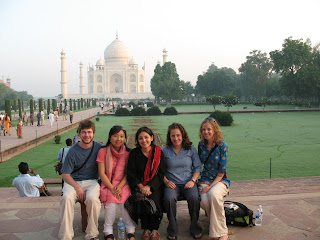
Taj Mahal during sunrise.
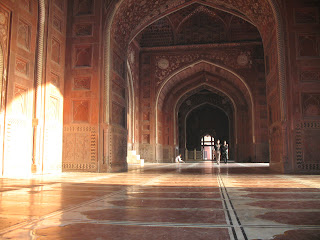
Inside the mosque adjacent to the Taj.
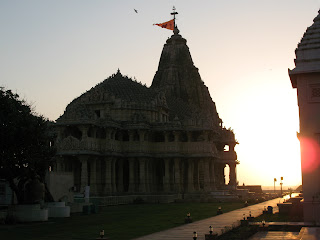
Temple at Somnath.
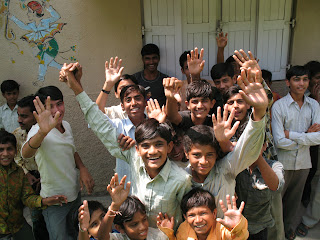
Students waving goodbye as we leave Babapur Ashram.
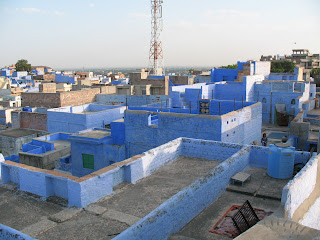
View of Jodhpur.
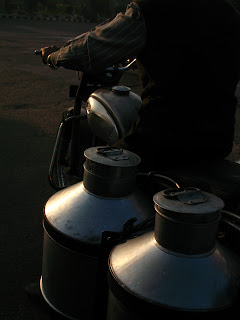
Dudwalla (milkman) in Jaipur. In villages (and in Mussoorie), they usually carry these canisters strapped to their backs.
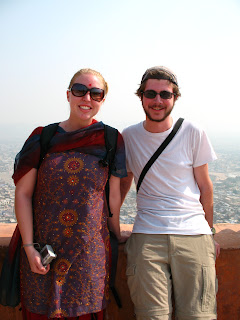
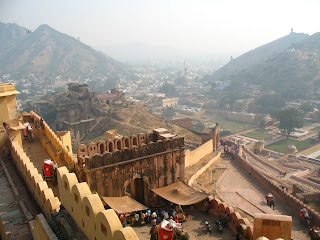
Overlooking Raja Man Singh's Amber Fort.
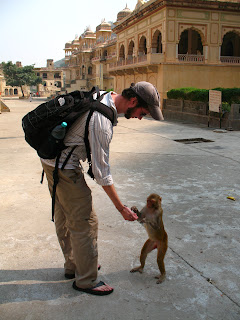
Low-fiving a monkey at Galta.

Galta, temple of the Sun God.
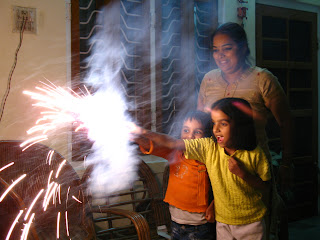
Celebrating Diwali with my homestay mother, Shobha, and sisters, Anahita and Shambouvi.
A few days after Amritsar we went to Agra to see the Taj Mahal, Fatehpur Sikri, and Shah Jahan's Agra fort. We then took a train Southwest to the state of Gujarat and stayed in a small village near the coast of the Arabian sea. For seven days we were in a Gandhian school called Babapur Ashram, adjusting to village life.
We made excursions to a number of religious sites including the Hindu pilgrimage site called Somnath and the Jain pilgrimage site of Palitana. The temple at Palitana was absolutely breathtaking.
After Babapur, a few days were spent in the Gujarat capital of Ahmedabad and we stayed in another Gandhian Ashram, this being the first one that Gandhi established and it was used for his headquarters until approximately 1930, called Vidyapeeth.
Another train ride was due, the next one being to the desert state of Rajasthan where I stayed in Jodhpur, the blue city, with a few friends for a four day break.
Afterwards we went to Jaipur, capital of Rajasthan, a city that is pulsing with life (one of the densest cities in India).
I've been living with my host family in Jaipur for a month now, continuing Hindi lessons, fieldwork, and lectures at the University of Rajasthan in earnest. This leg of the trip has been the most profound as living with my host family has drawn me into Indian culture more deeply than before. My family is a joint family: mother and father, two sisters, grand parents, uncle and aunt, and a German shephard.
Last night we celebrated Diwali, the festival of lights, with fireworks and pooja. This is the biggest Hindu holiday, which commemorates the end of Lord Ram's exile in the forest (hence the lights, to the light the way for his return).
In 36 hours, however, we leave Jaipur for Varanasi, the last substantial leg of my trip. Varanasi is arguably the holiest city in India and the oldest continually living city in the world.
Following are photos that roughly encompass the last 1.5 months.
Akbar the Great's Fatehpur Sikri
Taj Mahal during sunrise.
Inside the mosque adjacent to the Taj.
Temple at Somnath.
Students waving goodbye as we leave Babapur Ashram.
View of Jodhpur.
Dudwalla (milkman) in Jaipur. In villages (and in Mussoorie), they usually carry these canisters strapped to their backs.
Overlooking Raja Man Singh's Amber Fort.
Low-fiving a monkey at Galta.
Galta, temple of the Sun God.
Celebrating Diwali with my homestay mother, Shobha, and sisters, Anahita and Shambouvi.
25 September, 2007
Amritsar
We left Mussoorie on Friday and spent the weekend in Amritsar, the holiest city in the world for Sikhs - "the Mecca of Sikhism". Just 15 kilometers from the Pakistani border, Amritsar consists of especially busy streets with the densest crowds that I have experienced so far.
Crowds in India are especially fast-paced and hectic. Everyone is on a perpetual chase, desperately afraid of losing something: their luggage, their place in line, or the rickshaw at the head of the pack. Indians that I've talked to cite the unstable political climate during the last century as a cause for insecurity and lack of trust -"an every man for themself" mentality. I've noticed this feeling of unease every where that I've been: A person's facial expression will say "everything that I own may be swept away at any moment." A few weeks ago, I was sick at the hospital and remember the flood of people at the receptionist's desk, arms were raised carrying papers to be turned in. I remember standing in a crowd of patients that opened the side door and entered behind the counter to bypass the lines outside. The clerks were powerless and could only type so fast. After security guards managed to get them out, more waves of people lapped up against the closed door.
This is partly what made the Golden Temple in Amritsar so unique. After checking shoes at the counter, everyone peacefully and patiently waited to reach the communal sinks to wash hands and feet. Crowds of people from all religions conducted rituals, sang, and conversed. These were meditative crowds, emananating spirituality that seemed eerie in contrast to the city outside.
I entered the temple and met an old man who took it upon himself to guide me through the complex. He only knew a few English words but our combined efforts at foreign languages were sufficient for understanding each other. Walking up and down the floors I was frequently stepping over people who were deep in their own worlds. I was taught where and how to pray and to kneel, given a brief history of the temple, its structures made of pure gold, the Ten Gurus, and constantly reassured with hands placed on my shoulder, "all are welcome."
Lunch in the communal kitchen was an incredible experience. The staff is made of volunteers, anyone can take part at any station, cooking or cleaning. The amount of food far exceeded the demand, despite the seemingly countless rows of people. We all stared and wondered at each other as we ate, mutually sharing the alien yet welcoming feeling in the atmosphere.
We visited the Temple three times: in the Evening before dinner, at 10:30pm and at 4:00am to watch the closing and opening processions. Posted is also a picture of Jallianwalah Bagh, the site of General Dyer's 1919 Massacre.
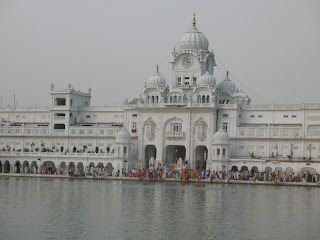
One of four entrances to the Golden Temple.
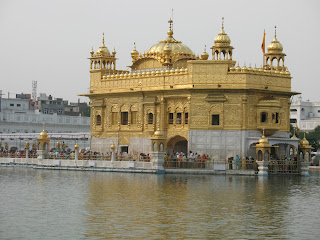
The Golden Temple
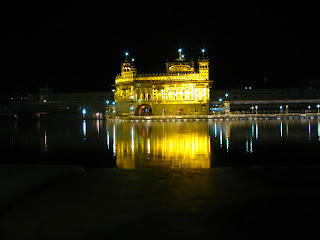
At Night.
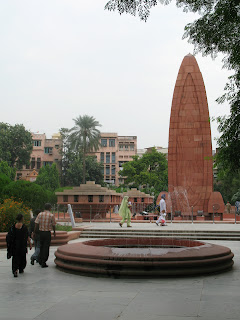
The Jallianwalah Bagh Massacre Monument.
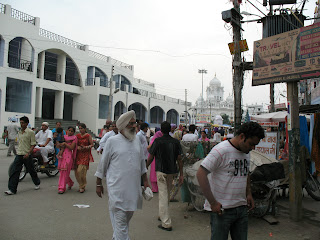
Amritsar
Crowds in India are especially fast-paced and hectic. Everyone is on a perpetual chase, desperately afraid of losing something: their luggage, their place in line, or the rickshaw at the head of the pack. Indians that I've talked to cite the unstable political climate during the last century as a cause for insecurity and lack of trust -"an every man for themself" mentality. I've noticed this feeling of unease every where that I've been: A person's facial expression will say "everything that I own may be swept away at any moment." A few weeks ago, I was sick at the hospital and remember the flood of people at the receptionist's desk, arms were raised carrying papers to be turned in. I remember standing in a crowd of patients that opened the side door and entered behind the counter to bypass the lines outside. The clerks were powerless and could only type so fast. After security guards managed to get them out, more waves of people lapped up against the closed door.
This is partly what made the Golden Temple in Amritsar so unique. After checking shoes at the counter, everyone peacefully and patiently waited to reach the communal sinks to wash hands and feet. Crowds of people from all religions conducted rituals, sang, and conversed. These were meditative crowds, emananating spirituality that seemed eerie in contrast to the city outside.
I entered the temple and met an old man who took it upon himself to guide me through the complex. He only knew a few English words but our combined efforts at foreign languages were sufficient for understanding each other. Walking up and down the floors I was frequently stepping over people who were deep in their own worlds. I was taught where and how to pray and to kneel, given a brief history of the temple, its structures made of pure gold, the Ten Gurus, and constantly reassured with hands placed on my shoulder, "all are welcome."
Lunch in the communal kitchen was an incredible experience. The staff is made of volunteers, anyone can take part at any station, cooking or cleaning. The amount of food far exceeded the demand, despite the seemingly countless rows of people. We all stared and wondered at each other as we ate, mutually sharing the alien yet welcoming feeling in the atmosphere.
We visited the Temple three times: in the Evening before dinner, at 10:30pm and at 4:00am to watch the closing and opening processions. Posted is also a picture of Jallianwalah Bagh, the site of General Dyer's 1919 Massacre.
One of four entrances to the Golden Temple.
The Golden Temple
At Night.
The Jallianwalah Bagh Massacre Monument.
Amritsar
10 September, 2007
Yamunotri
This weekend we trekked to Yamunotri, the source of the Yamuna River, which is one of the most sacred rivers in India. Yamunotri is situated at 11,000+ feet in the Himalayas, with the Yamuna glacier feeding the river from above and geothermal vents producing hot springs from below. The hike from the closest village, Janki Chatti, was 4 kilometers. We met interesting people on the way, hailing from all classes and castes, often on horseback, palanquins, or in baskets strapped to peoples' backs. I met a few pilgrims who were willing to correct my Hindi as I attempted to employ what little I know. At the temple we swam in the hot springs and performed puja.
The 12k walk back, from Janki Chatti to the next town called Hanuman Chatti (from Hanuman the monkey in the Ramayana) was breathtaking. Much of the trek was on cliff sides, overlooking enormous valleys with the Yamuna flowing through.
Yamunotri is the first of four legs in the most important pilgrimage, called Char Dham, that a Hindu can make in their life time (the other three parts are Gangotri (source of the Ganges), Kedarnath, and Badrinath).
Yamunotri Temple.
The Glacier.
Janki Chatti
02 September, 2007
Shaddi
On Wednesday night, our Director, Lisa, had a Hindu wedding with her husband for their 15th anniversary. I held the role of Lisa's brother in the ceremony, although I was praying to the porcelain gods when my part came up. Nonetheless, the puja ceremony was fascinating, much more interesting and entertaining than Christian weddings. The groom's father, for example, bargains with the bride's family for entrance into the wedding. At the conclusion of the ceremony, the groom must then bargain for his shoes (which the bride's sisters steal during the ceremony if his brothers fail to hold them at bay).

Lisa and Kevin during the ceremony with their son Neil.
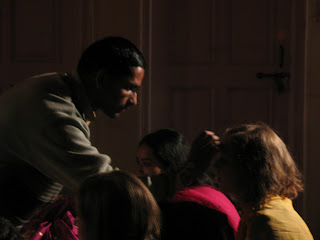
The Pandit.

Standing outside my room...
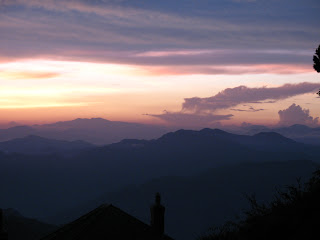
Again.
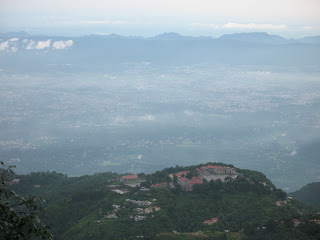
View on the way to school. Below is Dehradun, capital city of Uttaranchal.
Lisa and Kevin during the ceremony with their son Neil.
The Pandit.
Standing outside my room...
Again.
View on the way to school. Below is Dehradun, capital city of Uttaranchal.
26 August, 2007
Mussoorie
I arrived in Mussoorie a little over a week ago to begin Hindi classes. There are four hours of Hindi every morning and ~three hours of lectures/discussions in Contemporary and Historical India in the afternoon. Free time consists of exploring the villages and playing games with local kids and writing/reading at a few phenomenal cafes.
I've become friends with the manager of this internet cafe, named Balbir, but we all call him "Beer". He's been showing us the ropes around town and we go to his house during down time.
This weekend was spent on a farm called Navdanya, the home base for Vandana Shiva, an environmental activist. We did some work in the fields and learned the ways of local agriculture.
As I am finally falling in to a daily routine, the transition from euphoria to reality has been sinking in. The other students on the program are also starting to think about home a little more, especially when vignettes are shared from our respective schools. The last two weeks have been a blur, it feels like we've been in India for at least a month already. It's hard to believe that school is only starting now at home. This is not to say that homesickness is becoming an issue, but the occasional fieldtrip to Domino's Pizza is nonetheless welcomed.
My IFP is also beginning to take form. Recently, I've been meeting with our assistant directors who are both anthropologists for coaching. I'm learning that candid discussions with the average bystander is just as valuable as someone who may be directly involved in education. This means that I've been talking to children who have never gone to school, as well as their parents, just as much as I've spoken with teachers and students.
The responses I receive from people who are not so involved in education tend to be more honest and less framed and cautious. It's very clear, however, that due to the history of colonization, the Self and Other frame of mind still permeates every discussion. When I speak with the locals, the color of my skin and where I'm from is certainly taken into account and so responses come with a little hesitance or incredulity. While I try to penetrate the West - East, outsider - insider, foreigner - villager mentality, I'm obligated to acknowledge these institutions if any value is to be dredged out of what people tell me.

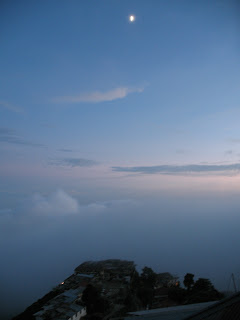
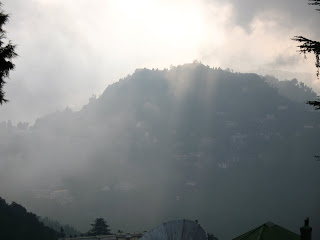
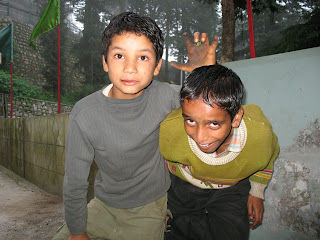

I've become friends with the manager of this internet cafe, named Balbir, but we all call him "Beer". He's been showing us the ropes around town and we go to his house during down time.
This weekend was spent on a farm called Navdanya, the home base for Vandana Shiva, an environmental activist. We did some work in the fields and learned the ways of local agriculture.
As I am finally falling in to a daily routine, the transition from euphoria to reality has been sinking in. The other students on the program are also starting to think about home a little more, especially when vignettes are shared from our respective schools. The last two weeks have been a blur, it feels like we've been in India for at least a month already. It's hard to believe that school is only starting now at home. This is not to say that homesickness is becoming an issue, but the occasional fieldtrip to Domino's Pizza is nonetheless welcomed.
My IFP is also beginning to take form. Recently, I've been meeting with our assistant directors who are both anthropologists for coaching. I'm learning that candid discussions with the average bystander is just as valuable as someone who may be directly involved in education. This means that I've been talking to children who have never gone to school, as well as their parents, just as much as I've spoken with teachers and students.
The responses I receive from people who are not so involved in education tend to be more honest and less framed and cautious. It's very clear, however, that due to the history of colonization, the Self and Other frame of mind still permeates every discussion. When I speak with the locals, the color of my skin and where I'm from is certainly taken into account and so responses come with a little hesitance or incredulity. While I try to penetrate the West - East, outsider - insider, foreigner - villager mentality, I'm obligated to acknowledge these institutions if any value is to be dredged out of what people tell me.
15 August, 2007
New Delhi
My travel to India went smoothly. The only delay was twenty-five minutes at Syracuse going to JFK. In fact, the refuel in London was supposed to take one hour and forty-five minutes but they called us back onboard about five minutes after getting off.
The Delhi airport was even easier. Despite the fact that we all felt a little self-conscious (twenty or so American kids marching through the airport), it seemed the world froze every time we turned the corner. Everyone was staring --except my customs officer, who didn't even care to look at my passport photo because the talk show on the overhanging television had his eyes glued.
The name of our apartment complex should speak for itself: Golf Links, which is a very upscale gated community almost smack in the middle of city. Every day has been filled with lectures from Indian authors, professors, film makers and politicians. Otherwise, the rest of my time has been devoted to feeling out Market areas, visiting museums, eating out, and I recently conducted my first interview for the fieldwork. Access to phones and computers is difficult so posts will probably be both brief and sporadic at best.
I would post pictures but I accidentally left my camera on its highest settings so each photo uses too much memory (thanks Rohit). Highlights of this week, however, include visits to Qutb Minar, Humayan's Tomb, and the Lodi Gardens.
The Delhi airport was even easier. Despite the fact that we all felt a little self-conscious (twenty or so American kids marching through the airport), it seemed the world froze every time we turned the corner. Everyone was staring --except my customs officer, who didn't even care to look at my passport photo because the talk show on the overhanging television had his eyes glued.
The name of our apartment complex should speak for itself: Golf Links, which is a very upscale gated community almost smack in the middle of city. Every day has been filled with lectures from Indian authors, professors, film makers and politicians. Otherwise, the rest of my time has been devoted to feeling out Market areas, visiting museums, eating out, and I recently conducted my first interview for the fieldwork. Access to phones and computers is difficult so posts will probably be both brief and sporadic at best.
I would post pictures but I accidentally left my camera on its highest settings so each photo uses too much memory (thanks Rohit). Highlights of this week, however, include visits to Qutb Minar, Humayan's Tomb, and the Lodi Gardens.
Subscribe to:
Posts (Atom)
